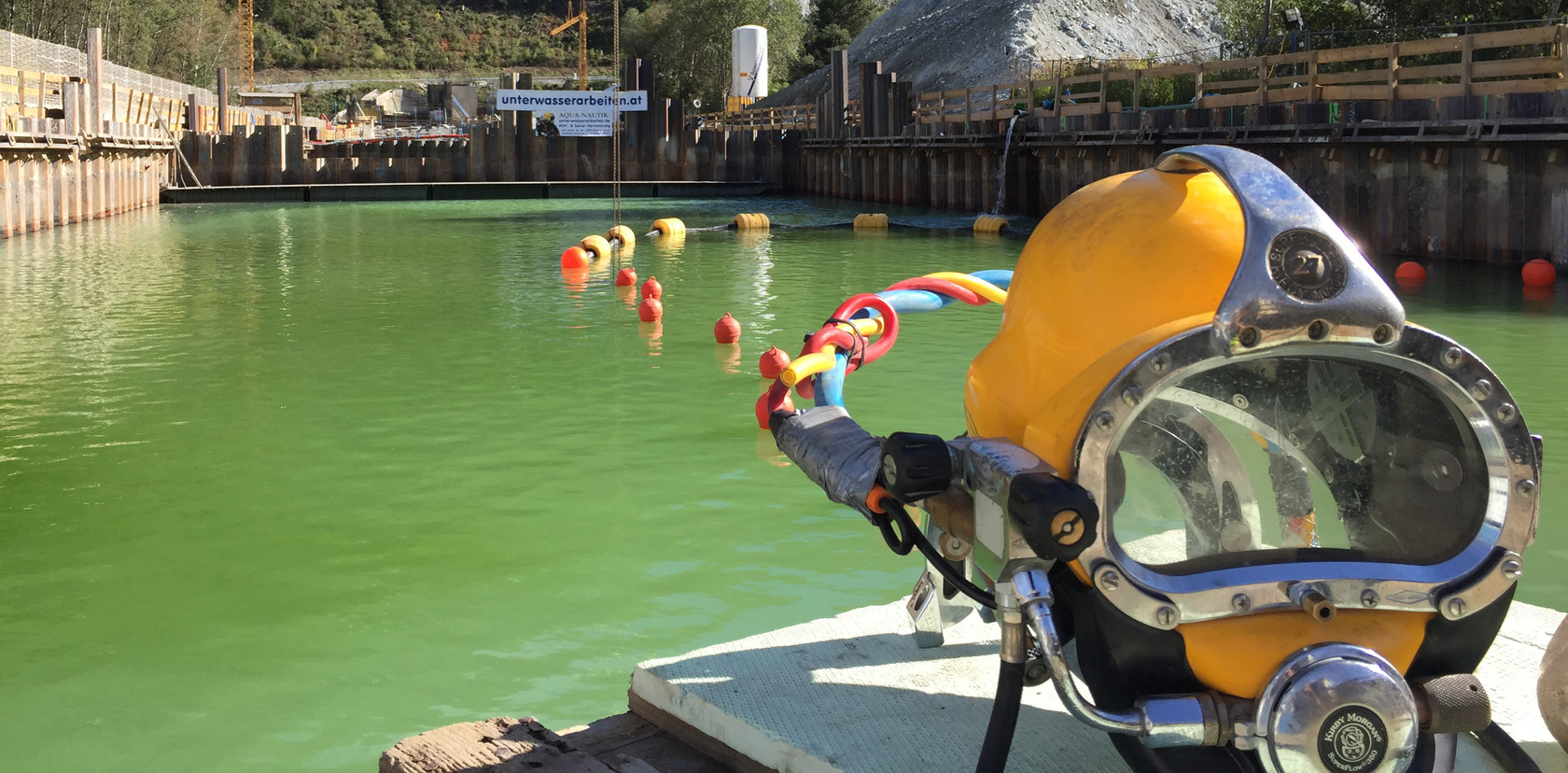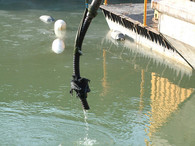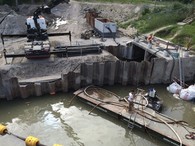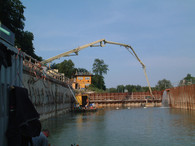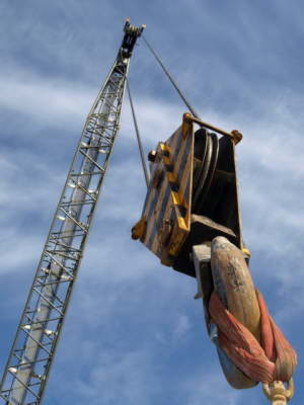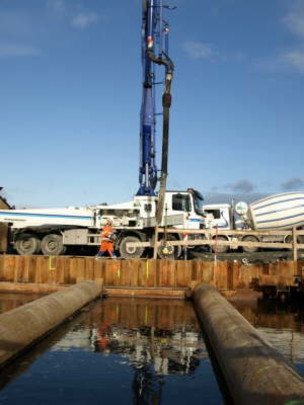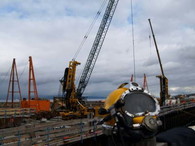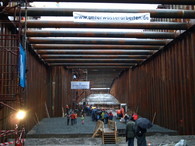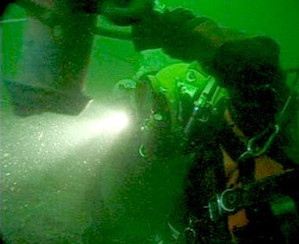We understand the term construction diving to include the creation of dry construction pits in high groundwater level areas.
A major challenge here is to handle the masses of sand, gravel and mud that accumulate under water.
Aqua-Nautik developed the option of separating solids, in particular sludge and clay components, from the conveying medium up to a volume flow of 520cy3/h and conveying clear water back into the construction pits with little equipment expenditure.
In addition, Aqua-Nautik has set itself the task of neutralizing the enriched alkaline water up to a volume flow of 160cy3/h during and after the underwater pouring.
In the following you can see different work performances of our construction diving department:
- UW-Beton und Sohlenvorbereitung
- Spezial: Skansen
- Ein- und Auslaufbauwerke an Industrie- und Kraftwerksanlagen
- Saug- und Spülarbeiten
- Dükerkontrollen
- Trinkwasserbrunnen
- Düker RheinEnergie
an excavation pit that is rarely seen anywhere else
Realization of the Lock Niederfinow is easy to see what work the divers usually have to perform in zero visibility.
Here you can clearly see which cement residues can arise when the tie back anchors are set, which afterwards have to be removed laboriously and tediously by divers.
We would like to thank Kaffenkahn e.V. for the permission to use the video.
Valve Installing WaStop® Inline Check Valve 71 in
Underwater Concrete / Sole Preparation

In order to create an underwater concrete foundation ("Tremie"), thorough preparation is essential.
1. Fine Leveling
i.e. the sole to be concreted must be leveled to the required level in order to be able to guarantee the sole strength. In most cases, the fine subgrade is created by underwater suction work.
2. Ensure Side Connections
i.e. the vertical connection points (side walls) of the later concrete base must be cleaned in order to guarantee the frictional connection between the UW concrete and the vertical boundary. To be on the safe side, so-called grouting hoses were inserted here in the past, which were possibly "grouted" with a cement suspension or with two component epoxi in order to close any breaches.
3. Clean and Equip the tie back anchor
Tie back anchors are used to anchor the concrete base back to prevent buoyancy. There are different methods of backup here. Probably the most frequently used is securing with so-called tie back anchors. These are placed in the base before concrete is poured in by drilling and grouting in a certain grid dimension. The task of the divers is to clear them from any grouting residues and to equip them with buoyancy protection (anchor plates).
4. Make the underwater concrete base “Tremie”
As soon as all preparations for the safe production of the base have been made, the pouring of the UW concrete will begin. The composition of the concrete depends, among other things, on the static requirements, the logistics for the UW concreting and the conditions of the area to be concreted, such as water depth or any interruptions in concreting. There are also various methods for placing the UW concrete. Depending on the system, concreting up to a slope of approx. 10% is possible.
Desludging of a construction pit, Commercial diving with a view
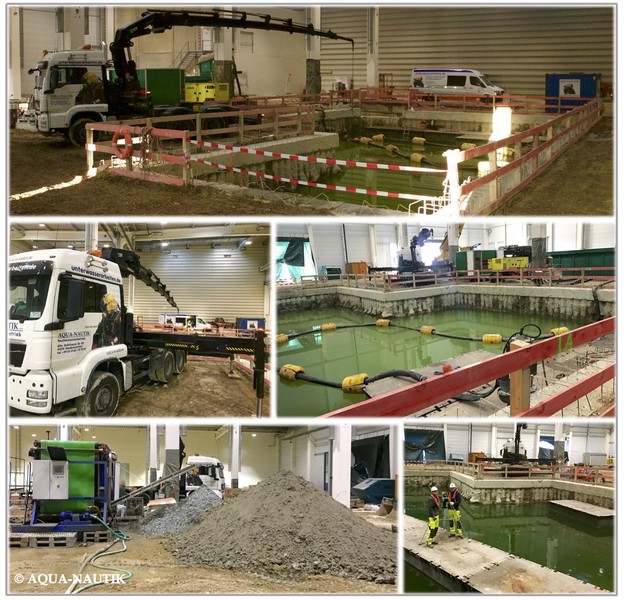
In the first quarter of 2017, the Aqua-Nautik team was busy removing sludge from a construction pit near Landshut. The task was to free the excavation pit within a large hall of pending clay and sludge in order to safely produce an underwater concrete base. The local space conditions and, above all, the clay and mud did not allow suction using conventional sedimentation basins. For this reason, a somewhat more complex, but much more effective method of excavation pit desludging was used here.
The soil water mixture is sucked off by a submersible excavator pump at approx. 350m³ / h and the zero content is separated from the water via a skip container and sludge drainage. The clean sludge-free water is fed back into the construction pit and what remains is a drained sludge cake that can be transported away directly without additional storage for drainage. The advantage is that almost no sludge remains in the excavation pit and the underwater work of the divers can be carried out insight, which is a significant quality advantage in the end result of the underwater concrete base.
Skansenløpet Concrete Tunnel in Trondheim, Norway
As part of the expansion of the E6 to relieve traffic in the city center, it was necessary to build a car tunnel to pass under the approach to Trondheim harbor. The tunnel construction has been divided into 5 sections, with the deepest part about 50ft below ground level.
The water depth was about 45ft depending on the tide. A total of around 7,200.00m³ of underwater concrete had been installed here up to a maximum gradient of 6.8% by December 2007. Time periods: Project start September 2006 Approval of the port access June 1, 2008 Completion of construction work: December 1st, 2008 Approval for car traffic is expected in 2009.
Some facts about the Skansenløpet concrete tunnel:
- A total of 552 yards long, open tunnel construction
- there are also 377ft west and 310ft east ramp
- Construction method “cut and cover”
- Sheet pile shoring, longest sheet pile wall 70ft with 6.2 tons.
- Underwater concrete/floor slab each 3ft thick
- Wall thickness 2.5ft
- Ceiling thickness 3ft
- Lane width 25ft
- Inner tunnel height 15ft
- Water height above the tunnel depending on the tide between 10ft and 15ft
Challenges in the project:
- Geological inventory
- Concrete technology
- Construction site technology
- Buoyancy problem
- Skansen railway bridge (tipping bridge from 1920 with wooden foundations)
- Fire safety
- Cultural monuments
- Traffic management
- Private and industrial residents
Diving work to build a Rhine culvert
Below the Rhein, RheinEnergie is building a supply tunnel, a so-called culvert, in which gas and telecommunications lines, among other things, will be laid. For this purpose, the starting pit in Niehl and the target pit in Mühlheim are dug on the banks of the river Rhein. The Rhein underpass is drilled from the starting pit to the target pit. In order to obtain a dry excavation pit, the divers from AQUA-NAUTIK GmbH are commissioned to create the underwater concrete bases.
For this purpose, after an excavation check, the actual depth must be determined using a plumbing plan. If the target specifications are not correct here, further digging must be done. This is done by flushing and suction work in connection with the excavator. A regular check by plumb bob ensures that the target depth is reached. After reaching the final depth, the sides of the excavation pit are cleaned of impurities by high pressure. With the cleaning, the divers achieve that no groundwater can be pushed up between the sheet pile wall and the concrete base. If the groundwater level in the excavation pit is too high, there is also the risk that the concrete floor will be pushed up by the groundwater. Due to the back anchoring with GEWI Anchors, the buoyancy forces are diverted and the underwater concrete base holds its position in a stable manner.

Compared to the work on the starting pit, the use in the target pit has to be described as extraordinary. Even the specifications cannot be compared with those of the starting pit. A first excavation check showed an ACTUAL depth of 45ft in the edge area and 60ft in the middle of the construction pit. In order to reach a target depth of 77ft from the top of the pit, a lot of excavation has to be moved here. When the TARGET depth is reached, the underwater concrete base can be created. The target pit with a diameter of 36ft, consists of 44 bored piles and is inspected by a first dive. Large overhangs are found on the bored piles, which pose a great danger to the execution of the underwater work. Unpredictable loosening and falling of the overhangs means unnecessary danger for the operational divers.
The removal of the overhangs on the bored piles can only be achieved with a maximum pressure of over 1000 bar. Further dives in which the suspension is removed from the GEWI Anchors is followed later by the equipping of the GEWI Anchors with anchor plates. Finally, the GEWI Anchors are brought to size and a final check of the excavation base is carried out before the scheduled concreting. In the end, AQUA-NAUTIK GmbH accompanies the pumping of the excavation so that nothing can stand in the way of the tunneling machine arriving on time.
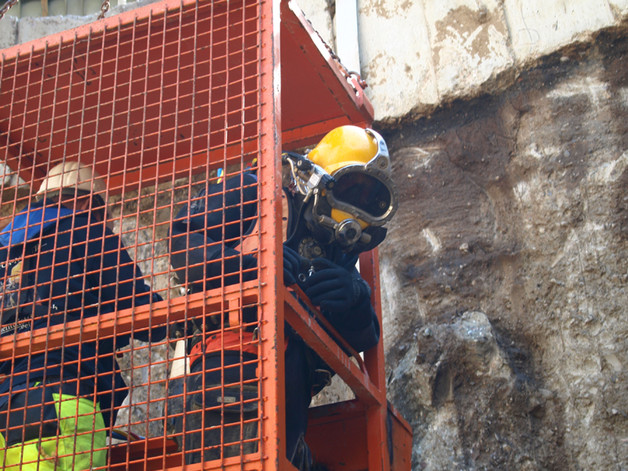
Inlet and outlet structures on industrial and power plants
These structures are subject to constant controls in order to keep the facilities up and running.
The tasks of the divers include documenting the condition of the structures or removing sand deposits if necessary.
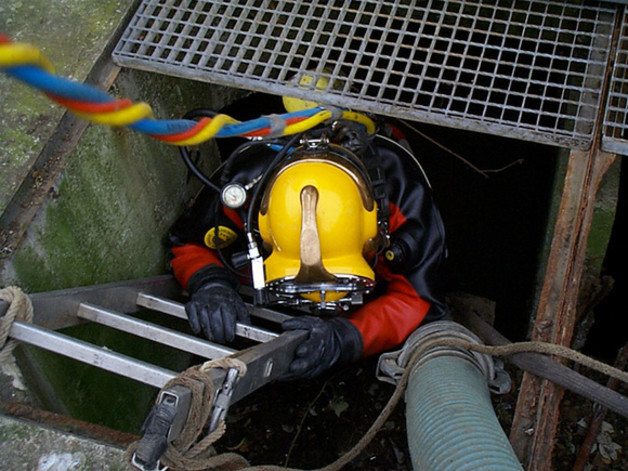
Suction and flushing work
Suction and flushing work is necessary in order to expose areas that have been sanded or to wash under objects in order to be able to carry out further work, e.g. in the area of rescue work. Suction work is carried out in water depths of 8 feet and above using the air injector principle. The water injector principle is used for water depths below 8ft.
This type of underwater work is required in a wide variety of areas, mainly in the production of fine subgrade for underwater concrete.
Culvert control

The culvert is a crossing structure with which a water or sewage pipe as an undercrossing pressure pipe is passed under a cut in the terrain or an obstacle (structure, river, railroad tracks, etc.).
These can be several hundred meters long. The construction of the culverts depends on the local conditions, as the flow conditions of individual streams and ditches differ at high, medium, and low water levels as well as the canal cross-sections. The culvert consists of an inlet and outlet structure and the culvert pipe in between.
The cross-section of the culvert pipe is usually circular or rectangular and with a length of 160ft to 325ft must have a diameter of at least 3ft so that it can be walked through. The culvert pipes were made either in steel construction with corrosion protection from epoxy resins or spun concrete or in concrete construction. Culverts on streams and ditches with large flood drains even have high and low water pipes to ensure drainage at all times.

